light FORD SUPER DUTY 2008 2.G Special Off-Road Package Supplement Manual
[x] Cancel search | Manufacturer: FORD, Model Year: 2008, Model line: SUPER DUTY, Model: FORD SUPER DUTY 2008 2.GPages: 25, PDF Size: 0.2 MB
Page 1 of 25
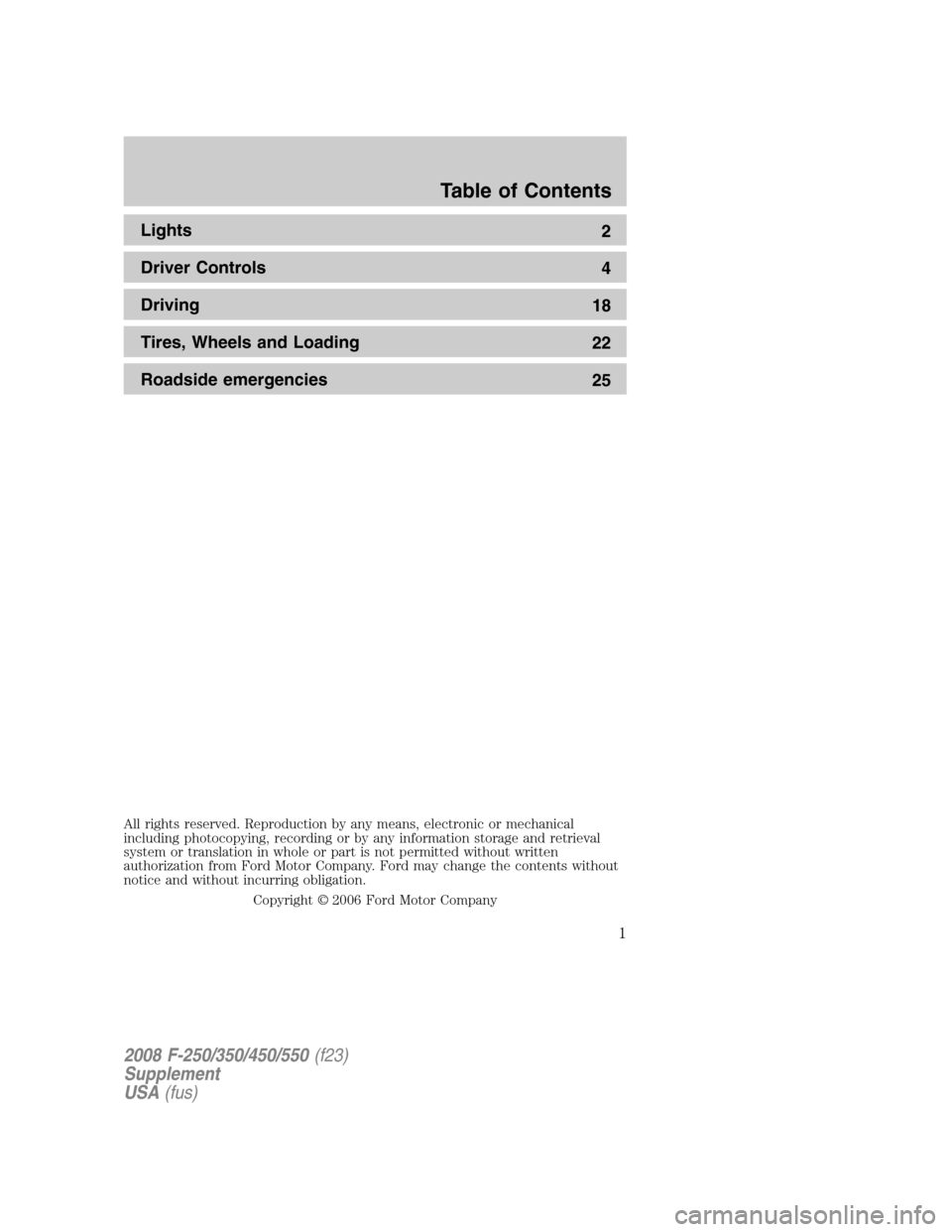
Lights
2
Driver Controls
4
Driving
18
Tires, Wheels and Loading
22
Roadside emergencies
25
All rights reserved. Reproduction by any means, electronic or mechanical
including photocopying, recording or by any information storage and retrieval
system or translation in whole or part is not permitted without written
authorization from Ford Motor Company. Ford may change the contents without
notice and without incurring obligation.
Copyright © 2006 Ford Motor Company
Table of Contents
1
2008 F-250/350/450/550(f23)
Supplement
USA(fus)
Page 2 of 25
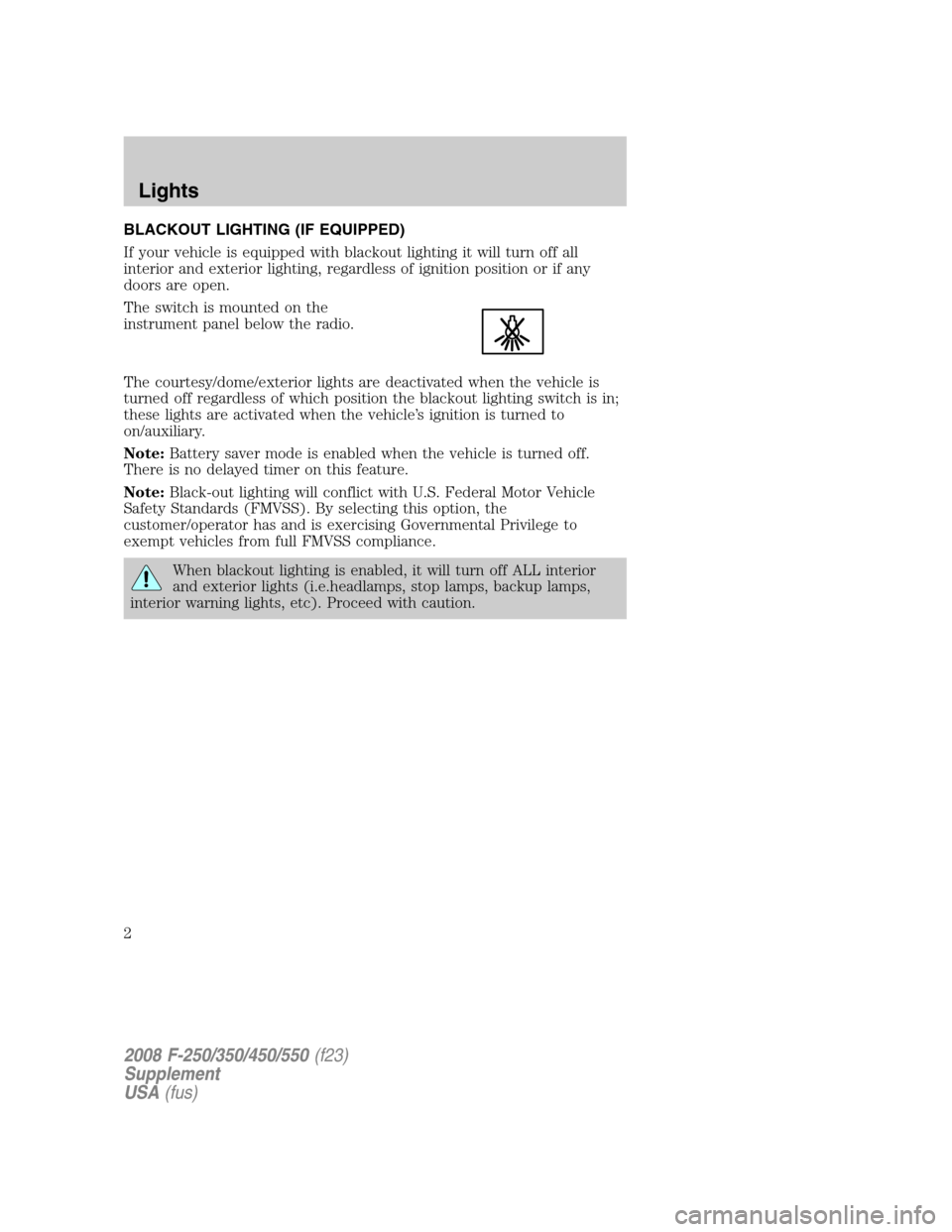
BLACKOUT LIGHTING (IF EQUIPPED)
If your vehicle is equipped with blackout lighting it will turn off all
interior and exterior lighting, regardless of ignition position or if any
doors are open.
The switch is mounted on the
instrument panel below the radio.
The courtesy/dome/exterior lights are deactivated when the vehicle is
turned off regardless of which position the blackout lighting switch is in;
these lights are activated when the vehicle’s ignition is turned to
on/auxiliary.
Note:Battery saver mode is enabled when the vehicle is turned off.
There is no delayed timer on this feature.
Note:Black-out lighting will conflict with U.S. Federal Motor Vehicle
Safety Standards (FMVSS). By selecting this option, the
customer/operator has and is exercising Governmental Privilege to
exempt vehicles from full FMVSS compliance.
When blackout lighting is enabled, it will turn off ALL interior
and exterior lights (i.e.headlamps, stop lamps, backup lamps,
interior warning lights, etc). Proceed with caution.
2008 F-250/350/450/550(f23)
Supplement
USA(fus)
Lights
2
Page 3 of 25

FOG LAMPS/REVERSING ASSIST LAMPS (IF EQUIPPED)
Your vehicle may be equipped with
fog lamps and reversing assist lamps
in the front bumper.
The fog lamps can be activated by
using the switch located below the
radio.
The reversing assist lamps are
automatically activated when the transmission is put into R (Reverse).
2008 F-250/350/450/550(f23)
Supplement
USA(fus)
Lights
3
Page 8 of 25

•Backup parts:Extra items such as an extra clevis/D-shackle or a
remote control unit should be carried in case of emergency. For
severe and/or continuous winch use, you may want to consider
including an extra wire rope and winch hook.
•Toolbox items:Always bring along hand wrenches, screwdrivers,
pliers and tools to change wire rope.
•Jumper cables:It’s always a good idea to carry jumper cables in case
your battery becomes drained during a winching operation. Also, a
dual battery system and a battery isolator kit can be installed to
prevent draining the electrical source during winching operation.
A fully charged conventional automotive battery with a minimum of 650
cold cranking amp is recommended to obtain peak performance from
your winch. Make sure all electrical connections are clean and tight.
Winch operation
Before you pull
Make sure the new rope is stretched before its first use. Unspool the
wire rope, leaving five wraps on the drum. Apply at least 500 lbs.
(227 kg) of tension. This can be done by setting up an anchor point and
pulling your vehicle to it at a slightly inclined, flat surface and letting the
vehicle roll.
Before you use your winch, remember these key points:
1. Think safety at all times.
2. Always take your time to assess your situation and plan your pull
carefully.
3. Always take your time when using the winch.
4. Use the right equipment for your situation.
5. Always wear leather gloves and do not allow the wire rope to slide
through your hands.
6. You and only you should handle the wire rope and operate the remote
control switch.
7. Practice. Practice and practice the steps.
Choosing an anchor point
A secure anchor is critical to winching operations. The anchor must be
strong enough to hold while winching. Natural anchors include trees,
stumps and rocks. Hook the rope as low as possible. If no natural
anchors are available, when recovering another vehicle, your vehicle
2008 F-250/350/450/550(f23)
Supplement
USA(fus)
Driver Controls
8
Page 12 of 25
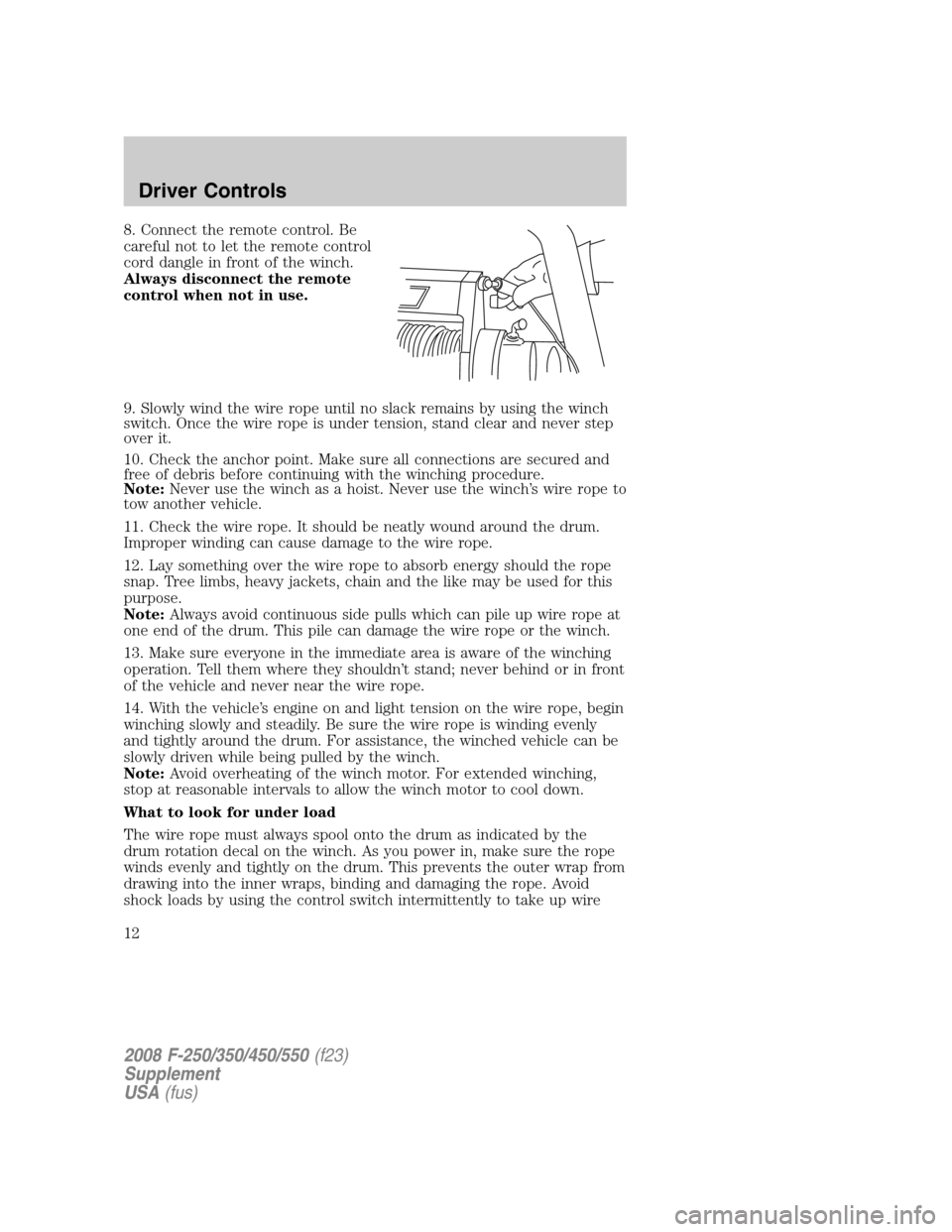
8. Connect the remote control. Be
careful not to let the remote control
cord dangle in front of the winch.
Always disconnect the remote
control when not in use.
9. Slowly wind the wire rope until no slack remains by using the winch
switch. Once the wire rope is under tension, stand clear and never step
over it.
10. Check the anchor point. Make sure all connections are secured and
free of debris before continuing with the winching procedure.
Note:Never use the winch as a hoist. Never use the winch’s wire rope to
tow another vehicle.
11. Check the wire rope. It should be neatly wound around the drum.
Improper winding can cause damage to the wire rope.
12. Lay something over the wire rope to absorb energy should the rope
snap. Tree limbs, heavy jackets, chain and the like may be used for this
purpose.
Note:Always avoid continuous side pulls which can pile up wire rope at
one end of the drum. This pile can damage the wire rope or the winch.
13. Make sure everyone in the immediate area is aware of the winching
operation. Tell them where they shouldn’t stand; never behind or in front
of the vehicle and never near the wire rope.
14. With the vehicle’s engine on and light tension on the wire rope, begin
winching slowly and steadily. Be sure the wire rope is winding evenly
and tightly around the drum. For assistance, the winched vehicle can be
slowly driven while being pulled by the winch.
Note:Avoid overheating of the winch motor. For extended winching,
stop at reasonable intervals to allow the winch motor to cool down.
What to look for under load
The wire rope must always spool onto the drum as indicated by the
drum rotation decal on the winch. As you power in, make sure the rope
winds evenly and tightly on the drum. This prevents the outer wrap from
drawing into the inner wraps, binding and damaging the rope. Avoid
shock loads by using the control switch intermittently to take up wire
2008 F-250/350/450/550(f23)
Supplement
USA(fus)
Driver Controls
12
Page 14 of 25

How to spool under no load
Arrange the remote control lead so it cannot be caught in the winch.
Arrange the wire rope so it will not kink or tangle when spooled. Be sure
any wire rope already on the spooling drum is wound tightly and evenly
layered (unspool and tighten and layer evenly, if necessary). Keep the
wire rope under light tension and spool the wire rope back onto the
winch drum in even layers. Stop frequently to tighten and straighten the
layers as necessary. Repeat this process until the winch hook is the same
distance as the full length of the remote control from the winch. Attach
the hook strap, then walk the wire rope toward the fairlead, carefully
spooling in the remaining rope by pulsing the remote control switch.
Store the hook at the fairlead or tensioned to a suitable location to the
side.
If you do not have the hook strap, use a length of cord or something
similar.
To help prevent serious injury,neverput your fingers inside the
hook area as you are powering in.
Rigging techniques
Various winching situations will require unique winching techniques.
These could range from too little distance to achieve maximum pull
using straight line rigging, simply increasing pulling power or maintaining
a straight-line pulling situation.
How to change the pulling direction
All winching operations should have
a straight line from the winch to the
object being pulled. This minimizes
the wire rope collecting on one side
of the drum which will affect pulling
efficiency and may damage the wire
rope. A snatch block, secured to a
point directly in front of the vehicle,
enables you to change the pulling
direction while allowing the wire
rope to be at 90° to wind properly
onto the drum.
2008 F-250/350/450/550(f23)
Supplement
USA(fus)
Driver Controls
14
Page 16 of 25
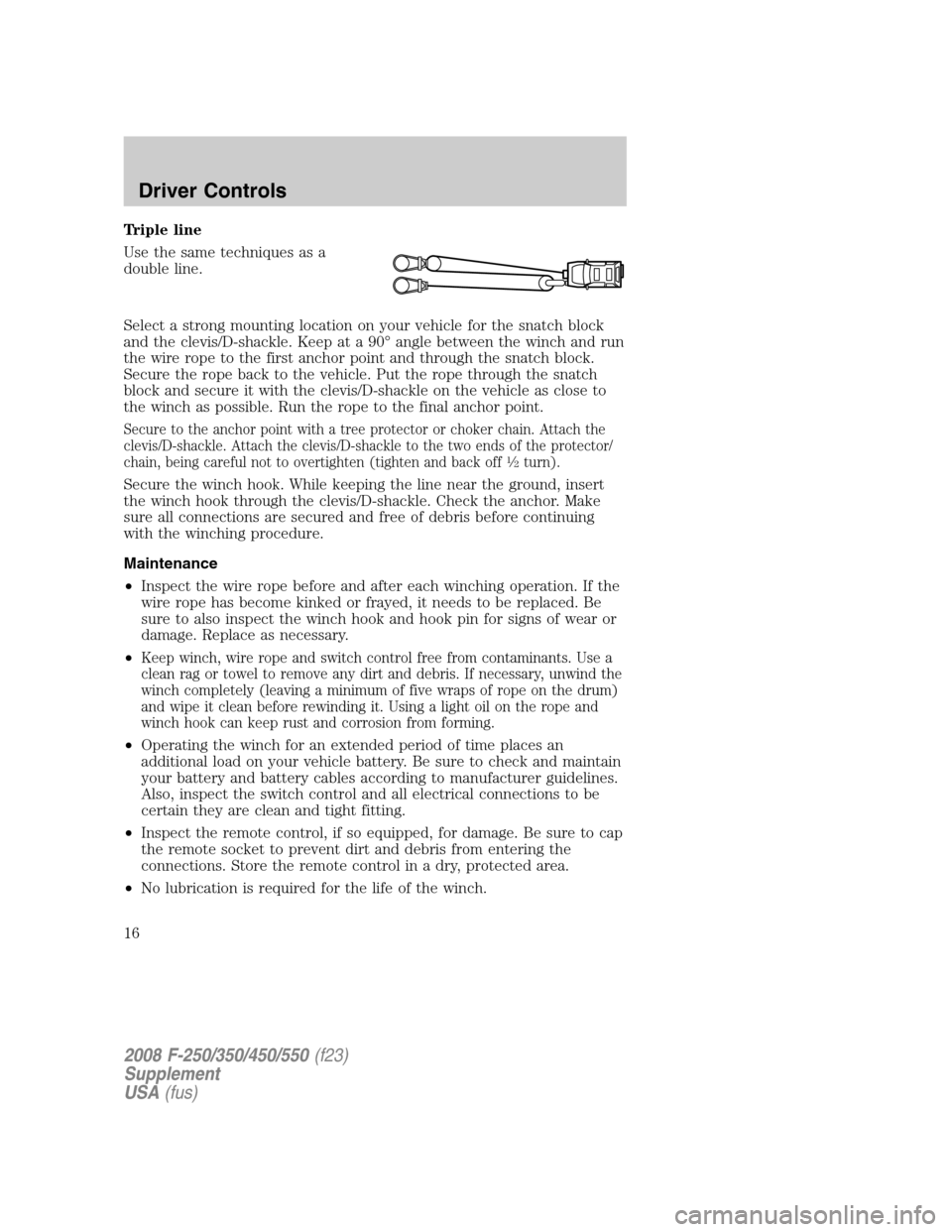
Triple line
Use the same techniques as a
double line.
Select a strong mounting location on your vehicle for the snatch block
and the clevis/D-shackle. Keep at a 90° angle between the winch and run
the wire rope to the first anchor point and through the snatch block.
Secure the rope back to the vehicle. Put the rope through the snatch
block and secure it with the clevis/D-shackle on the vehicle as close to
the winch as possible. Run the rope to the final anchor point.
Secure to the anchor point with a tree protector or choker chain. Attach the
clevis/D-shackle. Attach the clevis/D-shackle to the two ends of the protector/
chain, being careful not to overtighten (tighten and back off
1�2turn).
Secure the winch hook. While keeping the line near the ground, insert
the winch hook through the clevis/D-shackle. Check the anchor. Make
sure all connections are secured and free of debris before continuing
with the winching procedure.
Maintenance
•Inspect the wire rope before and after each winching operation. If the
wire rope has become kinked or frayed, it needs to be replaced. Be
sure to also inspect the winch hook and hook pin for signs of wear or
damage. Replace as necessary.
•
Keep winch, wire rope and switch control free from contaminants. Use a
clean rag or towel to remove any dirt and debris. If necessary, unwind the
winch completely (leaving a minimum of five wraps of rope on the drum)
and wipe it clean before rewinding it. Using a light oil on the rope and
winch hook can keep rust and corrosion from forming.
•Operating the winch for an extended period of time places an
additional load on your vehicle battery. Be sure to check and maintain
your battery and battery cables according to manufacturer guidelines.
Also, inspect the switch control and all electrical connections to be
certain they are clean and tight fitting.
•Inspect the remote control, if so equipped, for damage. Be sure to cap
the remote socket to prevent dirt and debris from entering the
connections. Store the remote control in a dry, protected area.
•No lubrication is required for the life of the winch.
2008 F-250/350/450/550(f23)
Supplement
USA(fus)
Driver Controls
16
Page 18 of 25

ANTI-LOCK BRAKE SYSTEM (ABS) DEACTIVATION IN 4WD
(IF EQUIPPED)
Refer to the label on the back of the sun visor mirror regarding Anti-lock
Brake System (ABS) operation.
Your vehicle’s Anti-lock Brake System (ABS) may be designed to
deactivate when 4WD Low is engaged. The ABS indicator (
ABS)
illuminates and stays on, to indicate that ABS is deactivated, as long as
4WD Low is engaged.
When 4WD Low is disengaged, the ABS light turns off and the system is
active again.
SUSPENSION UPGRADE PACKAGE
Your vehicle is equipped with a special suspension package that will
enhance the vehicle’s off-road performance. The vehicle will handle
differently, both on and off-road, from a factory-equipped passenger car
or truck.
Vehicles with a higher center of gravity such as utility and
four-wheel drive vehicles handle differently than vehicles with a
lower center of gravity. Utility and four-wheel drive vehicles are not
designed for cornering at speeds as high as passenger cars any more
than low-slung sports cars are designed to perform satisfactorily under
off-road conditions. Avoid sharp turns, excessive speed and abrupt
maneuvers in these vehicles. Failure to drive cautiously could result in
an increased risk of loss of vehicle control, vehicle rollover, personal
injury and death.
If the vehicle is not equipped with in-cab suspension controls, the shock
settings are preset and not adjustable inside the vehicle. Contact your
authorized technician to make any necessary adjustments. Maximum
pressure is 15 psi for off-road operation with maximum load.
2008 F-250/350/450/550(f23)
Supplement
USA(fus)
Driving
18
Page 20 of 25
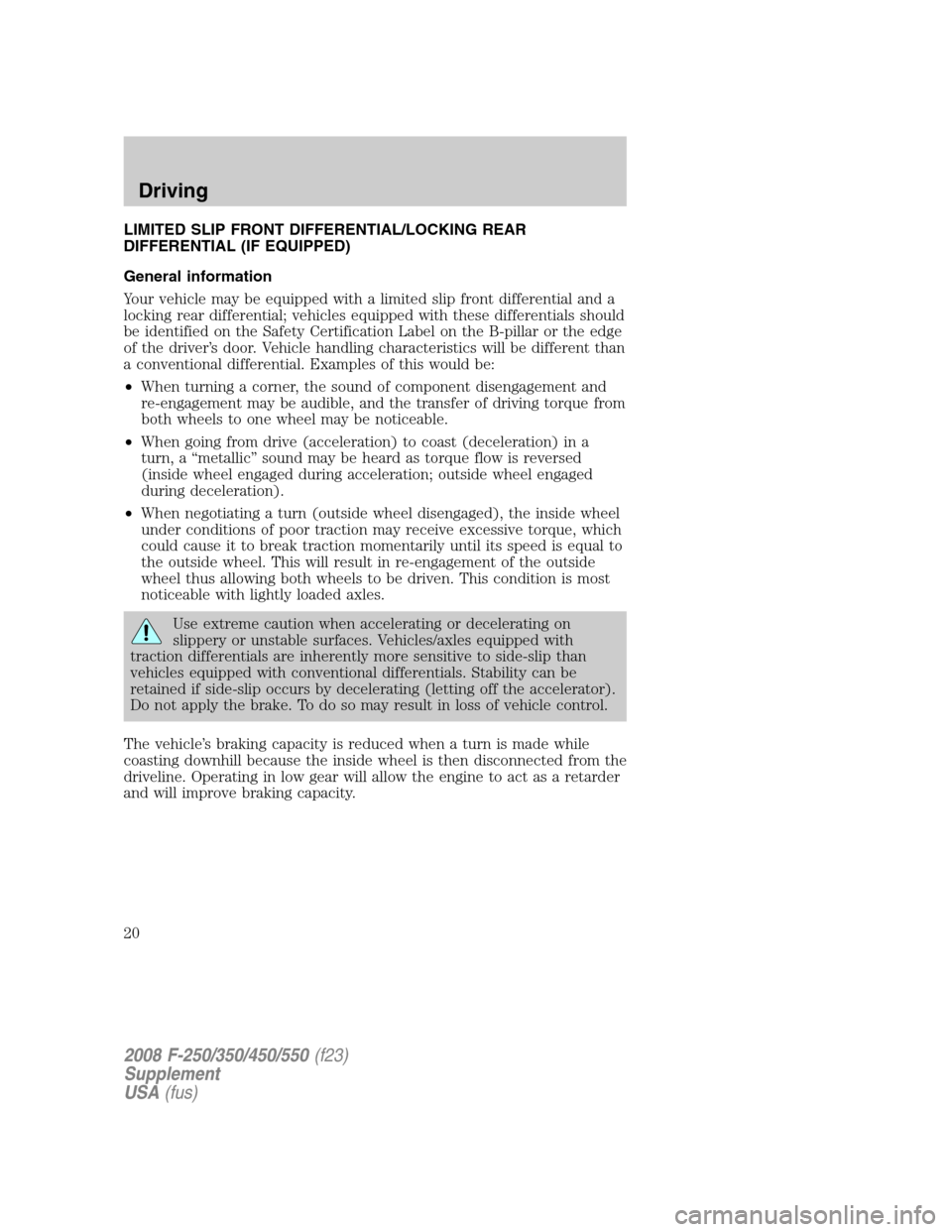
LIMITED SLIP FRONT DIFFERENTIAL/LOCKING REAR
DIFFERENTIAL (IF EQUIPPED)
General information
Your vehicle may be equipped with a limited slip front differential and a
locking rear differential; vehicles equipped with these differentials should
be identified on the Safety Certification Label on the B-pillar or the edge
of the driver’s door. Vehicle handling characteristics will be different than
a conventional differential. Examples of this would be:
•When turning a corner, the sound of component disengagement and
re-engagement may be audible, and the transfer of driving torque from
both wheels to one wheel may be noticeable.
•When going from drive (acceleration) to coast (deceleration) in a
turn, a “metallic” sound may be heard as torque flow is reversed
(inside wheel engaged during acceleration; outside wheel engaged
during deceleration).
•When negotiating a turn (outside wheel disengaged), the inside wheel
under conditions of poor traction may receive excessive torque, which
could cause it to break traction momentarily until its speed is equal to
the outside wheel. This will result in re-engagement of the outside
wheel thus allowing both wheels to be driven. This condition is most
noticeable with lightly loaded axles.
Use extreme caution when accelerating or decelerating on
slippery or unstable surfaces. Vehicles/axles equipped with
traction differentials are inherently more sensitive to side-slip than
vehicles equipped with conventional differentials. Stability can be
retained if side-slip occurs by decelerating (letting off the accelerator).
Do not apply the brake. To do so may result in loss of vehicle control.
The vehicle’s braking capacity is reduced when a turn is made while
coasting downhill because the inside wheel is then disconnected from the
driveline. Operating in low gear will allow the engine to act as a retarder
and will improve braking capacity.
2008 F-250/350/450/550(f23)
Supplement
USA(fus)
Driving
20
Page 21 of 25
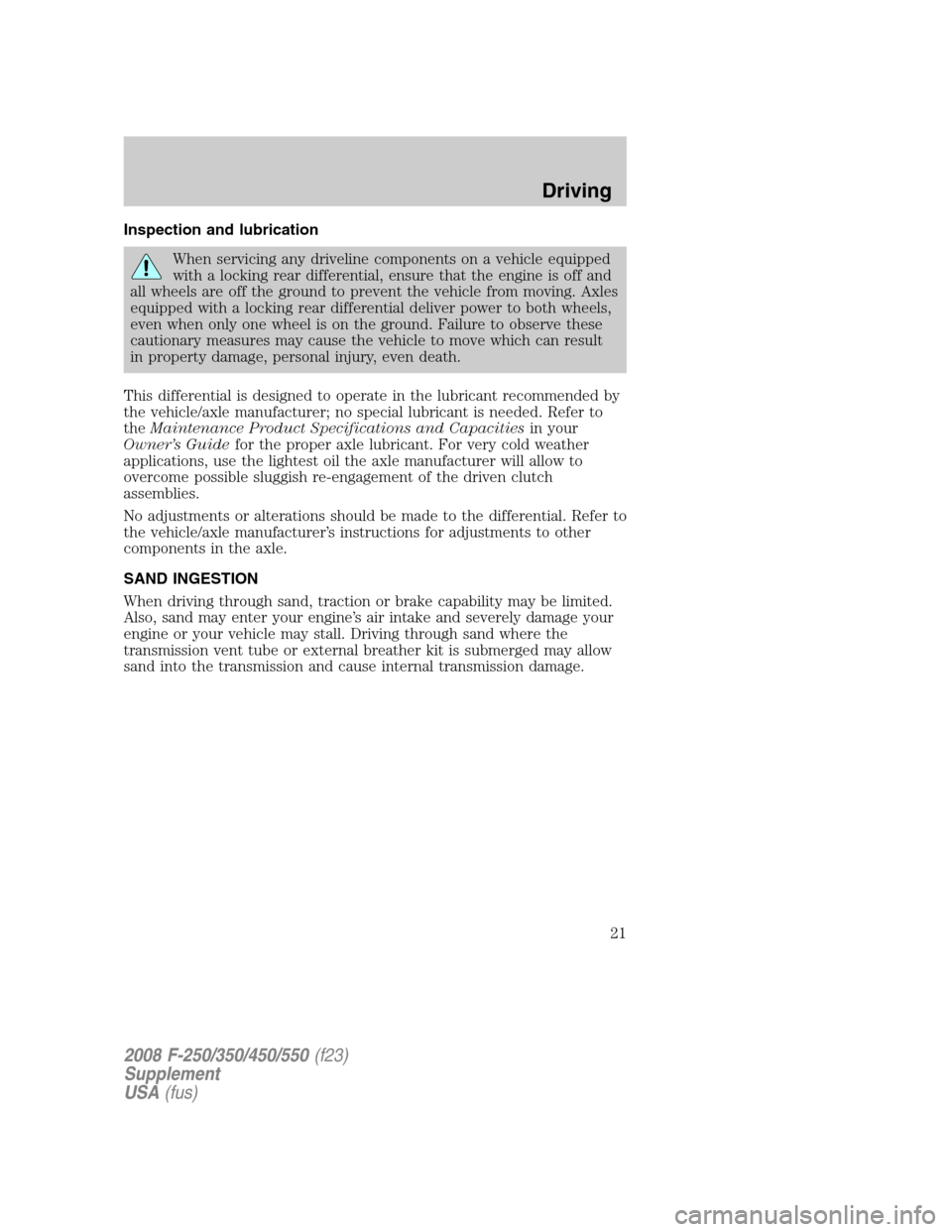
Inspection and lubrication
When servicing any driveline components on a vehicle equipped
with a locking rear differential, ensure that the engine is off and
all wheels are off the ground to prevent the vehicle from moving. Axles
equipped with a locking rear differential deliver power to both wheels,
even when only one wheel is on the ground. Failure to observe these
cautionary measures may cause the vehicle to move which can result
in property damage, personal injury, even death.
This differential is designed to operate in the lubricant recommended by
the vehicle/axle manufacturer; no special lubricant is needed. Refer to
theMaintenance Product Specifications and Capacitiesin your
Owner’s Guidefor the proper axle lubricant. For very cold weather
applications, use the lightest oil the axle manufacturer will allow to
overcome possible sluggish re-engagement of the driven clutch
assemblies.
No adjustments or alterations should be made to the differential. Refer to
the vehicle/axle manufacturer’s instructions for adjustments to other
components in the axle.
SAND INGESTION
When driving through sand, traction or brake capability may be limited.
Also, sand may enter your engine’s air intake and severely damage your
engine or your vehicle may stall. Driving through sand where the
transmission vent tube or external breather kit is submerged may allow
sand into the transmission and cause internal transmission damage.
2008 F-250/350/450/550(f23)
Supplement
USA(fus)
Driving
21